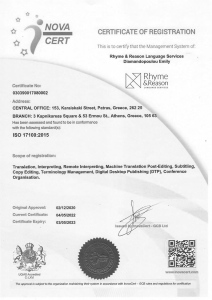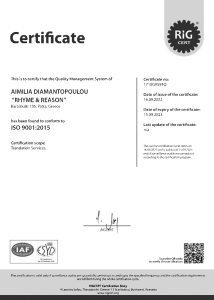Why choose Rhyme&Reason Language Services?
We provide translation services in over 110 language combinations. Our skilled translators have a thorough knowledge of the source language and are native speakers of their target language, with in-depth knowledge of the topics they translate. We excel in managing large translation projects in many languages, supporting all stages of your translation work using innovative technologies.
Quality Assurance: ISO 9001:2015 & ISO 17100:2015
Rhyme&Reason is certified according to ISO 9001:2015 & ISO 17100:2015 quality standards
Our ISO-certified translation management system helps us ensure the best result each time, minimising problems. We use state-of-the-art translation management technologies in all our processes, because, quite simply, they allow us to produce excellent results in the shortest possible time and at competitive prices.
Thanks to our flexibility and readiness to implement innovative services, we build relationships of trust with our clients from the private and public sector around the world.
What do you translate?
We undertake all sorts of projects in many formats and from various domains, thanks to our extended network of qualified translators and our dedicated DTP team. Indicatively, our areas of expertise include:
-
Banking & Finance
-
Certificates
-
Contracts & Law
-
Corporate Correspondence
-
Educational Material
-
EU texts
-
IT & Telecommunications
-
Medical & Life Sciences
-
Multimedia Presentations
-
Public Tenders
-
Renewable Energy Sources
-
Technical Documentation & Manuals
-
Tourism & Travel
-
Websites
File formats supported include: Office suites (Word, PowerPoint, Excel, Open Office, LibreOffice, Plain Text etc.), PDF, Web (XHTML, HTML, JSON, XML), InDesign, CAT-Tools (XLIFF), e-mail (.eml, .msg)
How do you translate?
First, we evaluate your project and send you a quote. Once you have accepted our quote and proceeded to the payment as agreed, we carefully assign your translation project to specialised linguists working in their native language. We build custom glossaries for large projects, ensuring terminology consistency, and use QA tools to guarantee a spotless result.
Will my translation have the same layout as the original file?
We maintain your document’s layout when dealing with editable formats (Word, Excel, PowerPoint, InDesign, etc.) and offer complimentary formatting for non-editable files to be translated.
Desktop Publishing (DTP) services are charged when requested as a separate service.
For the sake of efficiency, i.e. in order to speed up the translation process and avoid formatting mishaps, here are some tips to follow before sending us your files:
-
Avoid monolithic documents that are hundreds of mega-bytes in file size, rather organise content into smaller chunks in order to avoid memory problems on the translator’s PC.
-
Leave room in the layout for the translated text as it will expand in most cases. For example, Romance languages such as French, Spanish, Portuguese and Italian but also Eastern European languages such as Polish, Russian, Croatian, Serbian etc., compared to the same content in English will show a considerable text expansion. As a result, the translated text in many cases may no longer fit nicely into the layout.
-
Avoid text on pictures (JPG, PNG, TIFF) as in most cases, it cannot be extracted for translation. When creating translatable content, avoid the text functions in graphics applications such as Adobe Illustrator or Photoshop. Rather use InDesign, Word, Framemaker etc. to create the translatable content and the graphics application to create the visual content.
-
Avoid paragraph breaks in the middle of sentences, rather use soft line breaks for that purpose. Remember that when translatable text gets imported in a translation editor, the text is segmented, i.e. the translation editor creates smaller chunks, e.g. each sentence will become a segment. If you use the paragraph break to layout a document, the segments will get cut off in the middle and translation will become a nightmare.
-
Use styles, avoid manual formatting when creating layouts. Avoid creating indents using space or tab characters – if at all possible, use styles with automatic indentation.
-
When selecting a corporate font as part of your corporate identity, plan ahead whether you need to localise and into which languages you need to localise. Select a corporate font for your CI that supports all character sets of the languages you want to get your content localised into.
-
Avoid sending PDF files to translation. Prefer open formats. Even if content can in many cases be extracted from generated or scanned PDFs, the resulting target layout will not look as nice as when working with the underlying open text format.
-
Avoid embedding PDF documents into the main document, rather embed the open formats as those can be imported into the translation editor in most cases.
-
Before sending documents for translation, make sure you know which text must be and should not be translated and make sure to tell us about it. Modern translation environments avail of many functions that allow translators to include or exclude text for translation and thus control, which parts of the document are imported or ignored for translation.
Do you provide certified translations?
Do I need an Apostille and how can I get it?
Apostilles authenticate the seals and signatures of officials on public documents, so the documents can be recognised in foreign countries that are members of the 1961 Hague Convention Treaty. The Apostille always precedes the translation and therefore, you should contact the competent authority to issue it before having your document translated.
How can I count the words in my document?
Translation or editing jobs are generally priced per word. Most word processors provide a word count function. For instance, in Microsoft Word, the word count is indicated in the bottom left corner of the window.
If your file is not in editable format, use our
Request a quote form to upload the file and our project managers will get back to you with a word count.
As a ballpark estimate, a full A4 page of text contains about 250 words.
How can I use my smartphone to scan my documents for translation?
For iOS
Software
– Scan documents from the Notes App (pre-installed) on your device
You can use the Notes app to scan documents and add signatures on your iPhone, iPad, or iPod touch.
1. Open Notes and select a note or create a new one.
2. Tap the Camera button  , then tap Scan Documents
, then tap Scan Documents  .
.
3. Place your document in view of the camera.
4. If your device is in Auto mode, your document will automatically scan. If you need to manually capture a scan,
tap the Shutter button  or one of the Volume buttons. Then drag the corners to adjust the scan to fit the page, then tap Keep Scan.
or one of the Volume buttons. Then drag the corners to adjust the scan to fit the page, then tap Keep Scan.
5. Tap Save or add additional scans to the document
– Send a Scanned Document from iPhone
1. Once you’ve scanned your document and have it saved in your preferred location, you’re ready to attach it to an email and send it like any other regular attachment.
2. From your email account, start composing a new email message. From that message, select the option to add an attachment (often a paperclip icon).
3. Navigate to the location you selected to save your PDF to, such as Google Drive, or your device.
4. If you have difficulty locating your scanned document, check in the Files folder. The Files folder is a feature released in the iOS 11 update. If you have several documents in your Files folder, you can use the Search option to locate your desired file faster by file name. Select the document you want to attach, and it’s ready to email.
For Android
Software
– Scan documents with the Google Drive App (pre-installed) on your device
1. Open the Google Drive app  .
.
2. In the bottom right, tap Add  .
.
3. Tap Scan  .
.
4. Take a photo of the document you’d like to scan.
-
-
Adjust scan area: Tap Crop
 .
. -
Take photo again: Tap Re-scan current page
 .
. -
Scan another page: Tap Add
 .
. -
To save the finished document,
tap Done .
.
-
– Send a Scanned Document from an Android Device
1. Visit the app that created the attachment.
For example, to send a photo, open the Gallery or Pictures app.
2. View the specific item you want to attach.
3. In the Gallery app, view an image full-screen. In the Maps app, view the information card about a location.
4. Touch the Share icon.
5. A list of apps appears.
6. Choose Email or Gmail.
You may be prompted with an Always/Just This Once prompt. Choose Just This Once until you’re comfortable with specific apps on your phone.
7. Compose the message.
The item is attached to the message.
When and how will I receive my translation?
Our quotes specify delivery times, prices and payment methods.
Once you accept our quote and proceed with the payment as agreed, we will launch the translation process and deliver your project at the agreed time via e-mail, courier service (with an extra charge) or we can agree for you to pick it up in person at one of our offices.
Our office in Patras is open Monday to Friday, 09.00 – 17.00.
Our office in Athens is open Monday to Friday, 10.00 – 16.00.
How much does a translation cost?
We offer transparent pricing and a simple pricing structure, in principle based on volume of words to be translated. Upload your files using our Request a Quote form and our project managers will get back to you with a detailed quote within reasonable time.
How can I get a free quote?
Use our form to request a free quote for your project, e-mail us or visit our offices.
Do your prices include VAT?
Our quote prices do not include VAT.
24% VAT is applied to private clients in the EU, companies and individuals in Greece and EU-based companies that do not have a VIES-validated VAT number. You can validate VAT numbers here: https://ec.europa.eu/taxation_customs/vies/
How and when do I need to pay?
For the assignment of the task, please arrange for the deposit of the sum and the relevant proof of payment.
Payment methods accepted:
-
Bank transfer
BANK IBAN ACCOUNT HOLDER National Bank of Greece GR1801102260000022600212298 Aimilia Diamandopoulou Piraeus Bank GR8901725050005505031745520 Aimilia Diamandopoulou -
Debit or credit card via vivawallet
-
PayPal
-
Or at one of our offices (Athens or Patras)
We will also need you to provide the details for the issuance of an invoice (Name, Occupation, Tax Identification Number, Tax Office, Business Address) or receipt (name, address).
Which interpreting service is better suited to my needs?
Not sure what kind of interpreting service is adapted to your situation? Here’s a quick round-up of the different possibilities that we offer:
-
Consecutive Interpreting means that the interpreter translates after the speaker has finished. The interpreter is close to the speaker, listens carefully and takes notes. When the speaker takes a break or finishes, the interpreter translates the entire message. Consecutive interpretation is generally used in depositions, court cases, educational activities, testimonies, short business meetings, press conferences, medical discussions and job interviews.
-
Simultaneous Interpreting is the ability to hear a message in one language while simultaneously interpreting into another language. Simultaneous interpreting is very demanding and usually requires the use of special equipment. Qualified interpreters typically work in pairs when providing simultaneous interpretation services, to maintain a high level of concentration. Simultaneous interpreting is mainly used in large meetings, conferences, speeches, seminars, exhibitions and other large gatherings.
-
Simultaneous Remote Interpreting: RSI is basically Simultaneous Interpreting that significantly reduces costs and provides greater safety and adaptability as it does not require the physical presence of interpreters and equipment on-site. It works through cloud services and smart devices, ensuring a high-quality experience for participants. We offer simultaneous interpreting solutions for online meetings using WebEx, Zoom and other platforms.
How does Remote Simultaneous Interpreting work?
1. Speaker – the presenter speaks in one language. The speaker’s voice and image are transmitted live to an interpreter remotely, usually via an internet browser on a laptop or desktop computer.
2. Interpreter(s) – an interpreter listens and sees the speaker on a screen. Using high-quality headphones and microphone, they translate from the speaker’s language into another language, in real time.
3. Remote Simultaneous Interpreting Platform (RSI) – the interpreter’s speech is transferred to a cloud-based Simultaneous Remote Interpreting platform via laptop or desktop computer.
4. Audience – participants and/or representatives can connect to the Remote Simultaneous Interpreting platform via a computer or mobile device, viewing and listening to the speaker in their language of choice.
Why choose Remote Simultaneous Interpreting?
1. Reduced cost – reduces the cost of interpreting by more than 50% compared to the cost of traditional interpretation, without compromising on quality, thanks to no longer needing to rent expensive on-site interpreting equipment and having to pay interpreter travel costs.
2. Increased flexibility – conferences and press conferences often need to be organised in a short period of time. With Remote Simultaneous Interpreting you can offer multiple languages to your audience at any time, anywhere, either through receivers or smart devices.
3. Hassle-free technology – the days of expensive interpreter equipment at events are long gone. With Remote Simultaneous Interpreting, participants faithfully apply the “Bring Your Own Device” rule and listen in their own language.
4. More physical space – Remote Simultaneous Interpreting removes the need for soundproof booths for interpreters, thus freeing up valuable space.
5. Greater adaptability – with Simultaneous Remote Interpreting, events in inaccessible locations such as remote islands, resorts and mountains can now be served by leading interpreters.
When can Remote Simultaneous Interpreting (RSI) be used?
What are the benefits of Remote Simultaneous Interpreting (RSI)?
What is the difference between Translation and Localisation?
The difference between localisation and translation is that localisation covers the translation and cultural adaptation of digital information for local markets, taking into account the preferences and idiosyncrasies of each market to ensure the successful presentation of new products or services.
Software Localisation
When developing your software or application, adopting a global growth perspective is key. We have a great deal of experience with localisation practices and tools, so we can handle even the most technically demanding projects.
The right tools:
-
complete your systems,
-
support numerous file formats,
-
combine many language elements, such as translation memories, termbases, quality assurance settings and style guides, and
-
allow intra-country control for local customer groups.
Marketing Localisation & Transcreation
When entering new markets, translation – even when highly specialised – is not enough. To effectively implement a successful global marketing strategy, your message and your approach should definitely be as local as possible; thus, adapting the destination language to local audiences is essential.
Our goal is to convey the intent of your message and adapt it to a local context, while maintaining the style and tone of your brand.
Website Localisation
Your website is the window to the world. Today, wherever you are, you can reach the whole world. Marketing and selling your products or services around the world has never been easier.
Our clients can choose the content they wish to translate and into which languages, upload their files through our form and then with just one click they can send us the content for translation.
How do you handle subtitles?
We translate subtitles for:
-
Films
-
Series
-
Videos
-
Documentaries
-
Commercials
-
Interviews, etc.
-
Professional staff training videos
Our subtitles abide by the following quality rules:
1. Excellent translation quality, taking into account all the variations of the text on a cultural and vernacular level.
2. Simple syntactic sentences.
3. In cases where the dialogue needs to be condensed, the text retains its consistency.
4. The subtitles follow the rhythm of the dialogue, taking into account shot changes and sound effects.
5. The subtitles of children’s films follow the specifications set for this category of films.
6. The duration of subtitles is consistent with the reading speed of the average viewer.
7. The length of time that subtitles are visible for coincides with the rhythm of the film.
8. Exact correspondence between dialogue and the content of the subtitles.
9. The two languages are as synchronous as possible.
We provide translation services in over 110 language combinations. Our skilled translators have a thorough knowledge of the source language and are native speakers of their target language, with in-depth knowledge of the topics they translate. We excel in managing large translation projects in many languages, supporting all stages of your translation work using innovative technologies.
Quality Assurance: ISO 9001:2015 & ISO 17100:2015
Rhyme&Reason is certified according to ISO 9001:2015 & ISO 17100:2015 quality standards
Our ISO-certified translation management system helps us ensure the best result each time, minimising problems. We use state-of-the-art translation management technologies in all our processes, because, quite simply, they allow us to produce excellent results in the shortest possible time and at competitive prices.
Thanks to our flexibility and readiness to implement innovative services, we build relationships of trust with our clients from the private and public sector around the world.


We undertake all sorts of projects in many formats and from various domains, thanks to our extended network of qualified translators and our dedicated DTP team. Indicatively, our areas of expertise include:
-
Banking & Finance
-
Certificates
-
Contracts & Law
-
Corporate Correspondence
-
Educational Material
-
EU texts
-
IT & Telecommunications
-
Medical & Life Sciences
-
Multimedia Presentations
-
Public Tenders
-
Renewable Energy Sources
-
Technical Documentation & Manuals
-
Tourism & Travel
-
Websites
File formats supported include: Office suites (Word, PowerPoint, Excel, Open Office, LibreOffice, Plain Text etc.), PDF, Web (XHTML, HTML, JSON, XML), InDesign, CAT-Tools (XLIFF), e-mail (.eml, .msg)
First, we evaluate your project and send you a quote. Once you have accepted our quote and proceeded to the payment as agreed, we carefully assign your translation project to specialised linguists working in their native language. We build custom glossaries for large projects, ensuring terminology consistency, and use QA tools to guarantee a spotless result.
We maintain your document’s layout when dealing with editable formats (Word, Excel, PowerPoint, InDesign, etc.) and offer complimentary formatting for non-editable files to be translated.
Desktop Publishing (DTP) services are charged when requested as a separate service.
For the sake of efficiency, i.e. in order to speed up the translation process and avoid formatting mishaps, here are some tips to follow before sending us your files:
-
Avoid monolithic documents that are hundreds of mega-bytes in file size, rather organise content into smaller chunks in order to avoid memory problems on the translator’s PC.
-
Leave room in the layout for the translated text as it will expand in most cases. For example, Romance languages such as French, Spanish, Portuguese and Italian but also Eastern European languages such as Polish, Russian, Croatian, Serbian etc., compared to the same content in English will show a considerable text expansion. As a result, the translated text in many cases may no longer fit nicely into the layout.
-
Avoid text on pictures (JPG, PNG, TIFF) as in most cases, it cannot be extracted for translation. When creating translatable content, avoid the text functions in graphics applications such as Adobe Illustrator or Photoshop. Rather use InDesign, Word, Framemaker etc. to create the translatable content and the graphics application to create the visual content.
-
Avoid paragraph breaks in the middle of sentences, rather use soft line breaks for that purpose. Remember that when translatable text gets imported in a translation editor, the text is segmented, i.e. the translation editor creates smaller chunks, e.g. each sentence will become a segment. If you use the paragraph break to layout a document, the segments will get cut off in the middle and translation will become a nightmare.
-
Use styles, avoid manual formatting when creating layouts. Avoid creating indents using space or tab characters – if at all possible, use styles with automatic indentation.
-
When selecting a corporate font as part of your corporate identity, plan ahead whether you need to localise and into which languages you need to localise. Select a corporate font for your CI that supports all character sets of the languages you want to get your content localised into.
-
Avoid sending PDF files to translation. Prefer open formats. Even if content can in many cases be extracted from generated or scanned PDFs, the resulting target layout will not look as nice as when working with the underlying open text format.
-
Avoid embedding PDF documents into the main document, rather embed the open formats as those can be imported into the translation editor in most cases.
-
Before sending documents for translation, make sure you know which text must be and should not be translated and make sure to tell us about it. Modern translation environments avail of many functions that allow translators to include or exclude text for translation and thus control, which parts of the document are imported or ignored for translation.
We do provide translator-certified translations for your projects.
We also have partnerships with law firms for translations to be submitted to the Greek State requiring lawyer certification. Drop us a line for more information on how to proceed in such cases.
Apostilles authenticate the seals and signatures of officials on public documents, so the documents can be recognised in foreign countries that are members of the 1961 Hague Convention Treaty. The Apostille always precedes the translation and therefore, you should contact the competent authority to issue it before having your document translated.
Translation or editing jobs are generally priced per word. Most word processors provide a word count function. For instance, in Microsoft Word, the word count is indicated in the bottom left corner of the window.
If your file is not in editable format, use our
Request a Quote form to upload the file and our project managers will get back to you with a word count.
As a ballpark estimate, a full A4 page of text contains about 250 words.
For iOS
Software
– Scan documents from the Notes App (pre-installed) on your device
You can use the Notes app to scan documents and add signatures on your iPhone, iPad, or iPod touch.
1. Open Notes and select a note or create a new one.
2. Tap the Camera button  , then tap Scan Documents
, then tap Scan Documents  .
.
3. Place your document in view of the camera.
4. If your device is in Auto mode, your document will automatically scan. If you need to manually capture a scan,
tap the Shutter button  or one of the Volume buttons. Then drag the corners to adjust the scan to fit the page, then tap Keep Scan.
or one of the Volume buttons. Then drag the corners to adjust the scan to fit the page, then tap Keep Scan.
5. Tap Save or add additional scans to the document
– Send a Scanned Document from iPhone
1. Once you’ve scanned your document and have it saved in your preferred location, you’re ready to attach it to an email and send it like any other regular attachment.
2. From your email account, start composing a new email message. From that message, select the option to add an attachment (often a paperclip icon).
3. Navigate to the location you selected to save your PDF to, such as Google Drive, or your device.
4. If you have difficulty locating your scanned document, check in the Files folder. The Files folder is a feature released in the iOS 11 update. If you have several documents in your Files folder, you can use the Search option to locate your desired file faster by file name. Select the document you want to attach, and it’s ready to email.
For Android
Software
– Scan documents with the Google Drive App (pre-installed) on your device
1. Open the Google Drive app  .
.
2. In the bottom right, tap Add  .
.
3. Tap Scan  .
.
4. Take a photo of the document you’d like to scan.
-
-
Adjust scan area: Tap Crop
 .
. -
Take photo again: Tap Re-scan current page
 .
. -
Scan another page: Tap Add
 .
. -
To save the finished document,
tap Done .
.
-
– Send a Scanned Document from an Android Device
1. Visit the app that created the attachment.
For example, to send a photo, open the Gallery or Pictures app.
2. View the specific item you want to attach.
3. In the Gallery app, view an image full-screen. In the Maps app, view the information card about a location.
4. Touch the Share icon.
5. A list of apps appears.
6. Choose Email or Gmail.
You may be prompted with an Always/Just This Once prompt. Choose Just This Once until you’re comfortable with specific apps on your phone.
7. Compose the message.
The item is attached to the message.
Our quotes specify delivery times, prices and payment methods.
Once you accept our quote and proceed with the payment as agreed, we will launch the translation process and deliver your project at the agreed time via e-mail, courier service (with an extra charge) or we can agree for you to pick it up in person at one of our offices.
Our office in Patras is open Monday to Friday, 09.00 – 17.00.
Our office in Athens is open Monday to Friday, 10.00 – 16.00.
We offer transparent pricing and a simple pricing structure, in principle based on volume of words to be translated. Upload your files using our Request a Quote form and our project managers will get back to you with a detailed quote within reasonable time.
Use our form to get a free quote for your project, e-mail us or visit our offices.
Our quote prices do not include VAT.
24% VAT is applied to private clients in the EU, companies and individuals in Greece and EU-based companies that do not have a VIES-validated VAT number. You can validate VAT numbers here: https://ec.europa.eu/taxation_customs/vies/
For the assignment of the task, please arrange for the deposit of the sum and the relevant proof of payment.
Payment methods accepted:
-
Bank transfer
BANK IBAN ACCOUNT HOLDER National Bank of Greece GR1801102260000022600212298 Aimilia Diamandopoulou Piraeus Bank GR8901725050005505031745520 Aimilia Diamandopoulou -
Debit or credit card via vivawallet
-
PayPal
-
Or at one of our offices (Athens or Patras)
We will also need you to provide the details for the issuance of an invoice (Name, Occupation, Tax Identification Number, Tax Office, Business Address) or receipt (name, address).
Not sure what kind of interpreting service is adapted to your situation? Here’s a quick round-up of the different possibilities that we offer:
-
Consecutive Interpreting means that the interpreter translates after the speaker has finished. The interpreter is close to the speaker, listens carefully and takes notes. When the speaker takes a break or finishes, the interpreter translates the entire message. Consecutive interpretation is generally used in depositions, court cases, educational activities, testimonies, short business meetings, press conferences, medical discussions and job interviews.
-
Simultaneous Interpreting is the ability to hear a message in one language while simultaneously interpreting into another language. Simultaneous interpreting is very demanding and usually requires the use of special equipment. Qualified interpreters typically work in pairs when providing simultaneous interpretation services, to maintain a high level of concentration. Simultaneous interpreting is mainly used in large meetings, conferences, speeches, seminars, exhibitions and other large gatherings.
-
Simultaneous Remote Interpreting: RSI is basically Simultaneous Interpreting that significantly reduces costs and provides greater safety and adaptability as it does not require the physical presence of interpreters and equipment on-site. It works through cloud services and smart devices, ensuring a high-quality experience for participants. We offer simultaneous interpreting solutions for online meetings using WebEx, Zoom and other platforms.
1. Speaker – the presenter speaks in one language. The speaker’s voice and image are transmitted live to an interpreter remotely, usually via an internet browser on a laptop or desktop computer.
2. Interpreter(s) – an interpreter listens and sees the speaker on a screen. Using high-quality headphones and microphone, they translate from the speaker’s language into another language, in real time.
3. Remote Simultaneous Interpreting Platform (RSI) – the interpreter’s speech is transferred to a cloud-based Simultaneous Remote Interpreting platform via laptop or desktop computer.
4. Audience – participants and/or representatives can connect to the Remote Simultaneous Interpreting platform via a computer or mobile device, viewing and listening to the speaker in their language of choice.
1. Reduced cost – reduces the cost of interpreting by more than 50% compared to the cost of traditional interpretation, without compromising on quality, thanks to no longer needing to rent expensive on-site interpreting equipment and having to pay interpreter travel costs.
2. Increased flexibility – conferences and press conferences often need to be organised in a short period of time. With Remote Simultaneous Interpreting you can offer multiple languages to your audience at any time, anywhere, either through receivers or smart devices.
3. Hassle-free technology – the days of expensive interpreter equipment at events are long gone. With Remote Simultaneous Interpreting, participants faithfully apply the “Bring Your Own Device” rule and listen in their own language.
4. More physical space – Remote Simultaneous Interpreting removes the need for soundproof booths for interpreters, thus freeing up valuable space.
5. Greater adaptability – with Simultaneous Remote Interpreting, events in inaccessible locations such as remote islands, resorts and mountains can now be served by leading interpreters.
-
Conferences
-
Panel discussions
-
Online meetings
-
Seminars
-
Simplicity
-
Flexibility
-
Near zero carbon footprint
-
Excellent sound quality
-
Easy to use
-
Cost-effective
The difference between localisation and translation is that localisation covers the translation and cultural adaptation of digital information for local markets, taking into account the preferences and idiosyncrasies of each market to ensure the successful presentation of new products or services.
Software Localisation
When developing your software or application, adopting a global growth perspective is key. We have a great deal of experience with localisation practices and tools, so we can handle even the most technically demanding projects.
The right tools:
-
complete your systems,
-
support numerous file formats,
-
combine many language elements, such as translation memories, termbases, quality assurance settings and style guides, and
-
allow intra-country control for local customer groups.
Marketing Localisation & Transcreation
When entering new markets, translation – even when highly specialised – is not enough. To effectively implement a successful global marketing strategy, your message and your approach should definitely be as local as possible; thus, adapting the destination language to local audiences is essential.
Our goal is to convey the intent of your message and adapt it to a local context, while maintaining the style and tone of your brand.
Website Localisation
Your website is the window to the world. Today, wherever you are, you can reach the whole world. Marketing and selling your products or services around the world has never been easier.
Our clients can choose the content they wish to translate and into which languages, upload their files through our form and then with just one click they can send us the content for translation.
We translate subtitles for:
-
Films
-
Series
-
Videos
-
Documentaries
-
Commercials
-
Interviews, etc.
-
Professional staff training videos


